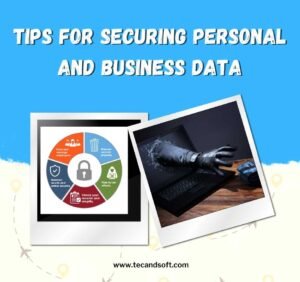In today’s interconnected world, protecting sensitive information has never been more crucial. Data breaches, identity theft, and cyberattacks pose serious threats to individuals and organizations. Implementing robust strategies to secure personal and business data can prevent financial loss and build trust and reputation. Let’s explore actionable tips for ensuring personal and business data to safeguard your digital assets effectively.

Understanding the Importance of Data Security
Data security is a cornerstone of modern digital interactions. It protects sensitive information from unauthorized access and ensures compliance with regulations like Protected Personal Information Laws. Whether managing personal information or corporate data, proactive steps are essential for mitigating risks.
Businesses are legally obligated to protect the identities of employees and customers, adhering to regulations like the General Data Protection Regulation (GDPR) and the California Consumer Privacy Act (CCPA). Failure to do so can lead to severe penalties, financial loss, and damaged reputations.
Start with Security Basics
What should you do first when sharing or transmitting sensitive data? Begin with a strong foundation:
- Encrypt data: Ensure all transmitted data is encrypted using robust algorithms.
Use strong passwords: Opt for complex passwords with letters, numbers, and symbols.
Limit access: Share sensitive data only with authorized individuals and verify their identities.
Update software regularly: Keep operating systems and applications updated to patch vulnerabilities.
Tips for Securing Personal and Business Data in the Workplace
Workplace security plays a pivotal role in protecting sensitive information. The stakes are high, whether customer details or proprietary business information.
- Implement Role-Based Access Control (RBAC): Restrict access to sensitive data based on an employee’s role. Not everyone needs access to everything.
- Conduct Regular Training: Educate employees on the importance of protecting personal information in the workplace. Teach them to recognize phishing scams and avoid clicking suspicious links.
- Enforce Strong Policies: Clearly outline rules for handling sensitive data and reinforce security protocols through regular reminders and updates.
- Monitor Employee Activity: Secure monitoring tools ensure employees handle data responsibly. However, it’s essential to comply with privacy laws and industry best practices.
How to Protect Personal Information Online
Personal information is a goldmine for cybercriminals. Here’s how to safeguard it online:
- Use Two-Factor Authentication (2FA): Add an extra layer of security by requiring a second form of verification, such as a code sent to your mobile device.
- Avoid Public Wi-Fi: Refrain from accessing sensitive data over unsecured networks. Use a Virtual Private Network (VPN) to encrypt your online activities.
- Beware of Phishing Scams: Scrutinize emails, texts, and links for signs of fraud before clicking.
- Regularly Monitor Accounts: Monitor bank accounts, credit reports, and social media profiles for unauthorized activity.
How to Protect Company Data from Employees
While employees are integral to any business, they can pose risks intentionally or inadvertently. Here’s how to mitigate these risks:
- Enforce Confidentiality Agreements: Require employees to sign confidentiality agreements explicitly stating their responsibility to protect company data.
- Restrict Data Copying: Use software solutions to prevent employees from copying or exporting sensitive files.
- Track Access Logs: Maintain detailed logs of who accesses sensitive information and when. This creates accountability and aids in auditing.
- Exit Protocols: Revoke access to systems and collect company-issued devices promptly when an employee leaves.
Protected Personal Information Laws and Compliance
Understanding and complying with Protected Personal Information Laws is critical for businesses. These laws define how sensitive data should be handled, stored, and shared to protect individuals’ privacy.
- Data Minimization: Collect only the data you truly need.
- Retention Policies: Dispose of old or unnecessary data securely to reduce the risk of breaches.
- Breach Notification: Have a clear plan to notify affected parties promptly in case of a breach.
By aligning with these laws, businesses reinforce trust and demonstrate a commitment to ethical practices.
Explain How Different Policies Reinforce Security and Comply with Industry Best Practices
Well-defined security policies are the backbone of effective data protection. They serve as a roadmap for employees, guiding their actions and ensuring compliance with industry standards.
- Bring Your Device (BYOD) Policy: Regulate using personal devices for work purposes to prevent unauthorized access.
- Password Management Policy: Enforce regular password updates and the use of password managers.
- Incident Response Plan: Equip your team to respond quickly to data breaches or security incidents.
These policies minimize risks and enhance resilience against evolving cyber threats.
Balancing Data Access and Security
Granting appropriate access to data is a delicate balance. The right balance prevents misuse while maintaining operational efficiency.
- Use Identity and Access Management (IAM) Systems: These tools ensure that only authorized personnel can access sensitive information.
- Segment Networks: Isolate critical data on separate servers to limit the impact of breaches.
- Audit Access Rights Regularly: Review and update permissions to match current job roles.
Advanced Tools and Technologies for Data Security
Technology can amplify your efforts in protecting personal and business data. Consider leveraging these solutions:
- AI-Powered Security Tools: AI can detect unusual patterns and thwart cyberattacks in real time. Transform your workflow with 10 powerful AI development tools to enhance security capabilities.
- Data Loss Prevention (DLP) Software: These solutions prevent the unauthorized sharing of sensitive information.
- Cloud Security Solutions: Use trusted cloud providers with advanced encryption and threat detection features.
Cultivating a Security-First Culture
Building a security-first culture within your organization ensures everyone prioritizes data protection.
- Leadership Commitment: Senior leaders should set an example by following security protocols.
- Gamification: Make security training engaging by introducing rewards for spotting phishing emails or reporting potential vulnerabilities.
- Continuous Learning: Provide regular updates on emerging threats and new best practices.
Key Takeaways for Securing Personal and Business Data
Protecting sensitive data is a multifaceted challenge requiring a proactive and holistic approach. By combining technological solutions, robust policies, and continuous education, you can fortify your defenses against cyber threats.
#TipsForSecuringPersonalAndBusinessData #ProtectingPersonalInformationInTheWorkplace #HowToProtectPersonalInformationOnline